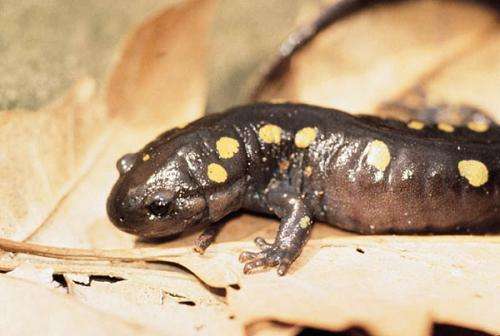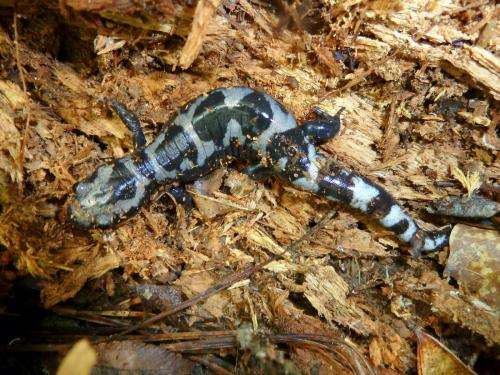Study of salamanders in ponds demonstrates 'invisible finger of evolution'

(Phys.org) —What do marbled and spotted salamanders in ponds in eastern North America have to teach us about biodiversity patterns elsewhere on Earth?
Plenty, if research conducted by biologist Mark Urban of the University of Connecticut is any guide.
In a paper published today in the journal Proceedings of the Royal Society B, Urban reports results that may fundamentally change how scientists view the importance of evolution in ecological research.
"This project looked closely at the separate and interactive contributions of genetic and environmental factors in shaping pond food webs," says Alan Tessier, program director in the National Science Foundation (NSF)'s Division of Environmental Biology, which funded the research.
"The results add to a growing understanding of the importance of genetic variation within species, and of eco-evolutionary processes in explaining patterns of biodiversity."
The findings show that the evolutionary divergence of populations is as important as biodiversity patterns based on ecological features, such as the presence of a top predator.
In this study, the subjects were the marbled salamander, an apex, or, top predator, in temporary ponds; the spotted salamander; and their shared zooplankton prey.
The marbled salamander breeds in the autumn. Its larvae grow under the ice of ephemeral ponds during winter.
As a result, marbled salamander larvae eat zooplankton all winter—and grow large enough to eat the spotted salamander larvae that hatch in these same ponds in late spring.
But Urban discovered that spotted salamanders sharing space with marbled salamanders have evolved so that they're born with voracious appetites.

Their increased foraging makes sense, he says, given that these salamanders live in ponds largely depleted of zooplankton prey, due to the presence of marbled salamanders.
The smaller salamanders need to grow quickly to reach a size at which marbled salamanders can't easily capture them.
"The evidence suggests that the repeated evolution of high foraging rates in spotted salamanders is an adaptive response to marbled salamander predation," says Urban.
Knowing how apex predators such as marbled salamanders structure biological communities, he says, requires that scientists understand their direct ecological effects as predators, and their indirect effects via the natural selection they impose.
"Finding that adaptive evolution may disguise strong ecological effects means that a range of ecological predictions are likely to be unreliable if we ignore how evolution affects biological communities."
Urban refers to this as "the invisible finger of evolution" which, he says, may tip the scales toward or away from ecological influences.
"That the effect of an apex predator can be so strong that it causes evolutionary responses in other species," he says, "shows that ecology and evolution are inexorably intertwined."
More information: Evolution mediates the effects of apex predation on aquatic food webs, rspb.royalsocietypublishing.or … .1098/rspb.2013.0859
Journal information: Proceedings of the Royal Society B
Provided by National Science Foundation



















